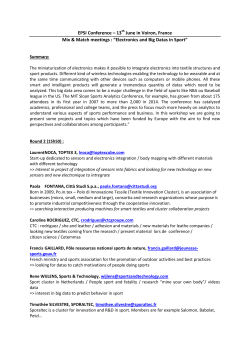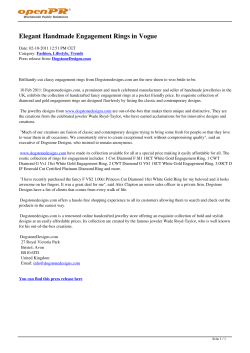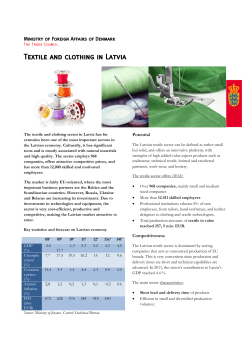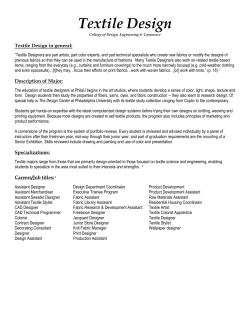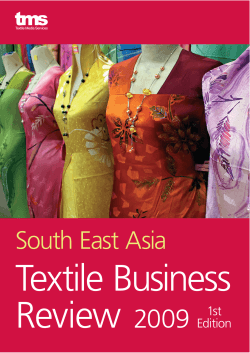
DESIGN PATTERNS PROTECTING
PROTECTING PATTERNS DESIGN If you design or manufacture patterned textiles or fabrics, you need to be careful not to copy other people’s textile designs and find yourself entangled in legal issues, writes Intellectual property lawyer Sharon Giconi. 30 WWW.ATFMAG.COM CASE STUDY Louis Vuitton Parody Essentially, you will “infringe” someone else’s copyright if you “substantially reproduce” the design or drawing in question. In March 2012, the University of Pennsylvania Law School created some controversy when it used a parody of Louis Vuitton Malletier’s famous “circled flower” and “LV” pattern to promote an intellectual property symposium (see below). Read on for some interesting “war stories” that have taken place in real life and gain some valuable tips along the way. Remember, drawings and patterns on fabrics, textiles, t-shirts and the like are generally protected under copyright law as “artistic works”. Essentially, the pattern was a “take off” of the Louis Vuitton design but instead used the legal © and ™ symbols. Textile designs that you have created What about the 10% rule? First up, we will turn to the issue of protecting your own textile designs. Contrary to popular misconception, there is no such thing as the “10% rule”. In essence, the only “safe” way to minimise the risk of being sued by someone else for copying is to ensure that your design is entirely original and unique. If you have copied a significant aspect of the design (such as the signature feature), even if it is only a small part of the overall design, liability may arise. You pretty much need to start from “scratch” without reference to any other designs. Even though it is legitimate to be inspired by general fashion trends and other fabric designs, be wary: if you take too much “perspiration” without enough of your own “inspiration” you could be challenged. Further, if you chose a particular print from overseas and asked your manufacturer here to copy it (even with some differences), that could still be copyright infringement as copyright laws apply internationally. Likewise, nothing could be worse than a textile designer working on a unique textile design only to be copied by someone else. While you may not think these things could happen to you, law firms deal with these issues all the time. When is a design too close? For their efforts the Law School received a “cease and desist” letter from the Louis Vuitton’s Director of Civil Enforcement, the Law School was able to eloquently argue that the law allowed for non-commercial use for a parody. Using contractors to create designs Alternatively, you could purchase ready-made patterned fabric from a reputable supplier. Getting ideas from the catwalk Clients often ask if they can reproduce a textile design that they have seen overseas or on catwalks on their own printed fabrics and clothing ranges. Unfortunately, the straight answer is “no”. This would amount to a slavish “copy” and be a flagrant infringement of copyright. The reason for this is that copyright laws are international and protect what’s known as “artistic works” including patterns and pictures on textiles. The whole purpose of copyright law is to provide people with incentive to create by giving them protection against “copycats”. Again, if you legitimately produce fabric with the design on it, that may be okay. The concerns arise if you substantially reproduce other designs on your own fabrics. Leaving parodies aside, often clients make the mistake of thinking that they own copyright just because they paid someone to create a design exclusively for them. For example, textile design companies often use contractors to design patterns and illustrations or even take photographs to reproduce on digital prints and textiles. The flyer used by University of Pennsylvania Law School However, even if you pay “good money” to use the designs, you will not own the copyright in them unless copyright is formally assigned in writing. While this may seem to be a “small technical glitch” at first glance, it can lead to great practical and legal implications later. For example, if someone copies your design and you do not own copyright, you cannot legally enforce it against them. Tip: It is important to get the copyright in the design assigned to you in writing if you are using a contractor rather than an employee who designs for your business. The Louis Vuitton pattern 31 What about Indigenous designs? Sometimes you may wish to take elements of indigenous paintings and incorporate these into your own textile or fabric designs. While this may seem innocent enough, as you are only copying “simple patterns”, be careful as these patterns and paintings are protected under copyright law. Further, this can attract a lot of publicity due to the cultural sensitivity surrounding certain indigenous works. CASE STUDY The carpet case In 1994, Aboriginal artists took legal action against a rug company for replicating Indigenous Australian art on woven carpets. As well as copying and infringement, because Indigenous artworks carry significant story-telling purposes the Court also found that errors in reproduction could cause serious offence to the communities. Apparently, the rug company had to pay over $100,000 to the living artists and the estates of the deceased artists. For example, Levi Strauss & Co has, in addition to the word “LEVI’S”, owns several registered trade marks for stitching on the back pocket of jeans and for the red tag on the back pocket of jeans, including: Australian trade mark number The actual marks 304665 328729 302847 Can patterns and designs be registered as trade marks? So if you produced your own jeans label and used a red tag like this one on the back pocket, you could infringe LEVI’s trade mark rights. Leaving copyright aside, trade marks are also very relevant to this area. Famous clothing patterns which are registered Many years ago, when the market was less sophisticated, people would often recognise an associated clothing range exclusively with its brand name or logo. For example, the word “LEVI’S” would be associated with a pair of jeans and a tick with Nike. Pictured below are some well-known trade marks that comprise patterns or elements of clothing which are all registered as trade marks in their own right. Louis Vuitton 304665 1278039 Burberry’s check 708955 However, now, shapes, colours and patterns of stitching are trade marks as well. Something as simple as a rectangular red tag on the back pocket of a pair of jeans also equates to? You guess it, LEVI’s! Australian law recognises the value of this and numerous clothing companies have capitalised on their well-known brands by registering them as trade marks. You may be able to do this too. 32 WWW.ATFMAG.COM David Jones houndstooth 659441 A Gucci pattern 1210026 Tip: If you have a signature element of your textiles these could be considered as trade marks. CON C L US IO N CONCLUSION While the law in this area can be very complex, it is always best to exercise caution and know your rights. Obviously, the simplest rule of thumb is that if you design something from scratch without any reference to anyone else’s design or trade mark, this is far “safer” than using too much of someone else’s. Also ensure that you own copyright in the designs and where relevant, consider trade mark protection. DISCLAIMER As with all areas of the law, it is recommended to seek legal advice tailored to your own circumstances. This article is of a general nature only. ABOUT THE AUTHOR Sharon Givoni is an intellectual property lawyer who has been running her own legal practice for over 12 years with many clients in the textile and fashion industry. She can be contacted by email (sharon@iplegal.com.au). Website: www.sharongivoni.com. au. She is very reputable and known for giving legal advice in plain English. Call her for a chat about your brand on 0410 557 907. 33
© Copyright 2025



